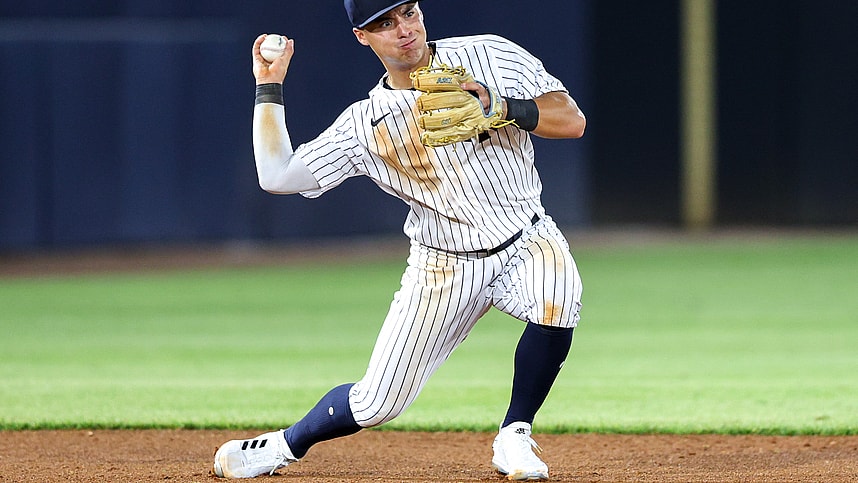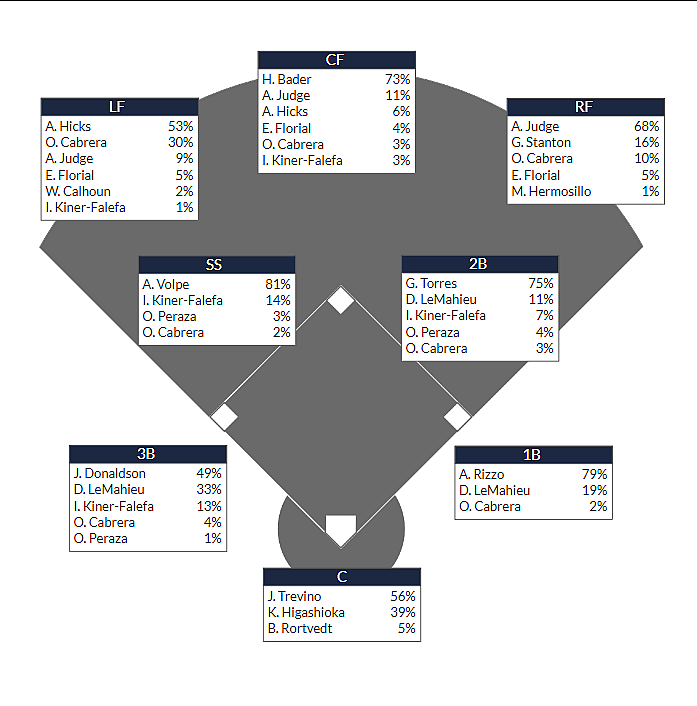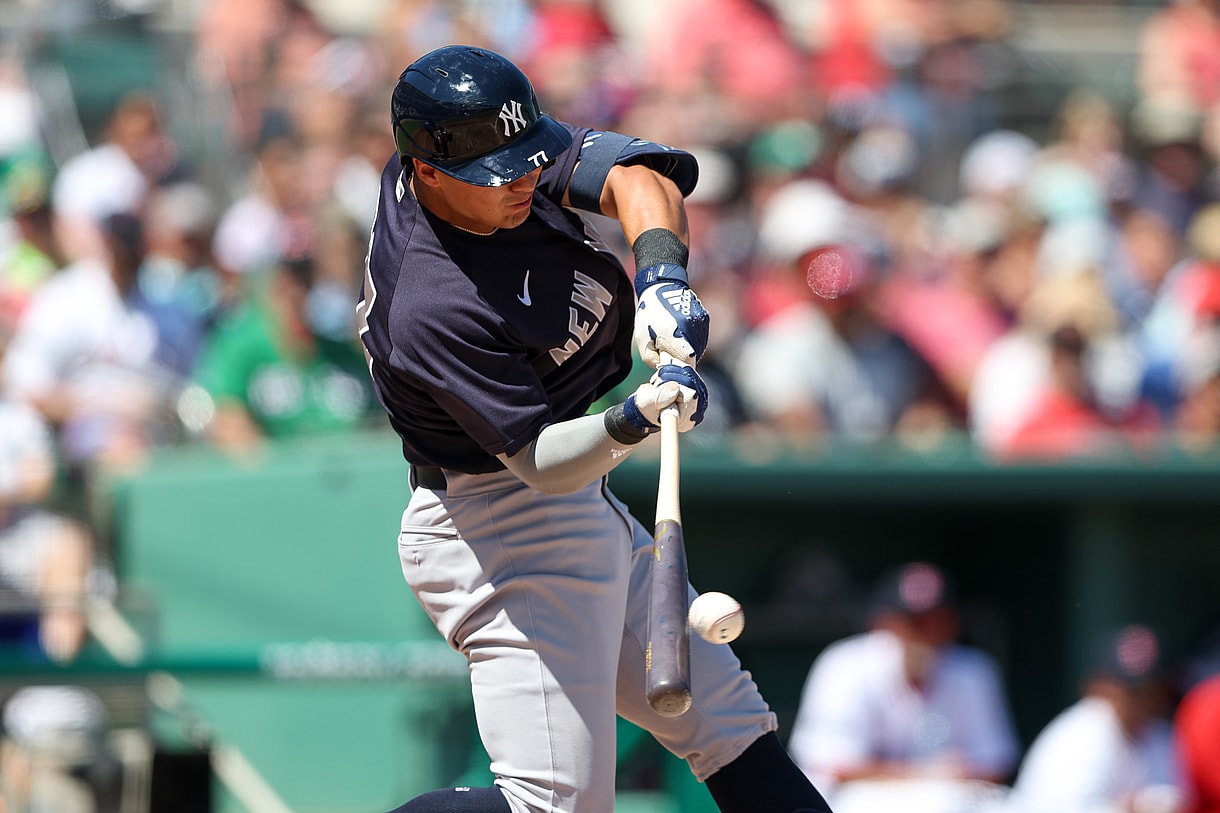
In the summer of 2019, the Yankees spent their 1st Round pick on shortstop Anthony Volpe, who had a commitment to Vanderbilt to play alongside his High School teammate Jack Leiter, but opted instead to sign with his favorite team as a kid. A New Jersey native, Anthony Volpe saw his stock rise after his performance with Team USA, where he had an OBP and SLG north of .500 in the U18 tournament. He was the Yankees’ #11 prospect on MLB Pipeline and #14 on FanGraphs prior to his full-season debut in 2021, with reports seeing him as a defense-first infielder who could play a utility role long-term.
He’s come a long way since that point in his career, he’s now one day away from trying to become the long-term solution to the shortstop position. The expectations are high, but Anthony Volpe is more than equipped to handle it.
- The Yankees should not be deterred by Kyle Tucker’s poor market
- The Yankees might have found their next Luke Weaver in $2 million signing
- Yankees predicted to land Bo Bichette but the reason is ludicrous
Providing the Skills the Yankees Have Always Wanted:
When you ask scouts, executives, and most importantly, the Yankees themselves, athleticism and speed are areas they’ve wanted to improve in. General Manager Brian Cashman made changes to the roster ahead of the 2022 season, getting rid of four of their five worst baserunners in 2021, according to BsR. Gio Urshela, Luke Voit, Gary Sanchez, and Jackson Frazier combined for a grotesque -14.8 BsR, a total so pitiful that just the four of them would have been the 4th worst baserunning team in the sport that season. The only notable speedster the Yankees added to the everyday lineup that offseason was Isiah Kiner-Falefa, but it was addition by subtraction for the Bronx Bombers.
The Yankees finished with a -5.7 BsR in 2022, which was still in the bottom half of the league, but somehow a massive improvement over their 2021 squad. Still, work had to be done on their roster to ensure that they would be more dynamic on the basepaths. New rules in 2023 would ensure that teams with more speed would be rewarded, as new pickoff rules and bigger bases have caused an uptick in steals, but the Yankees seemingly wouldn’t have the speed to take advantage of it. That is at least with their 2022 lineup, and while there are plenty of returning faces, Anthony Volpe is part of a youth injection that you can expect to see in 2023.

With 50 steals in 57 attempts, Anthony Volpe not only displayed incredible aggression on the basepaths, but he also showed great efficiency in doing so. Stealing is more difficult at the Major League level due to improved defense and more veteran pitchers, but it’s not unreasonable to expect that he’ll remain aggressive at the Major League level, even if you have to regress that number. It’s clear that the Yankees not only want to but need to be a more dynamic team on the basepaths. They’ve tried to outslug their opponents, and while they’ve run good offenses, they’ve routinely found themselves outscored by better lineups, and by better lineups, I mean the Houston Astros.
I’m not going to excuse losing to the Houston Astros in four consecutive postseason matchups with them since 2015, but two of those teams have serious arguments for being the greatest lineups of the modern era. There’s clearly another angle the Yankees could try to get ahead of most playoff contenders on, and that’s speed. Anthony Volpe’s shown off blistering sprint speed numbers not just in the Minor Leagues but also in Spring Training. Take this mad dash on a misplayed ball from Nick Castellanos, for example, as he turns what should be a double into an easy triple.
His ridiculous speed and high motor blend into a player that can make plays on the basepaths and create runs, and while he’ll need to remain disciplined and not cost his team outs, he’s shown that ability at every level of the game. Harrison Bader returning sometime in April is going to help as well, alongside Oswaldo Cabrera and Aaron Hicks, as they spend time around the lineup and on the basepaths. It’s a faster team than the one we saw for most of the year in 2022, and that’s something that the Yankees desperately need.
Anthony Volpe will rival Harrison Bader in terms of speed, and according to most projections, he will be the Yankees’ #1 base stealer in 2023. Another aspect of the Yankees that changed dramatically between 2021 and 2022 was their defense, as they experienced a +170 increase in DRS and a +43 increase in OAA, something that was a dramatic change from the team’s identity in recent years. The Yankees cleaned up their position players between the margins, and they were a far better team than their 2020 and 2021 counterparts for it. Say what you want about Brian Cashman, but he didn’t shy away from making those much-needed changes.
The trade for Josh Donaldson has become wildly unpopular, and that’s for good reason, but you can’t discredit his defensive improvement over Urshela. Remember the four players we mentioned as huge culprits for the Yankees’ baserunning woes? Well, they factor into this as well.
- Gio Urshela: -5 DRS/-5 OAA
- Luke Voit: -2 DRS/-2 OAA
- Gary Sanchez: -10 DRS/-2.5 FRM
- Jackson Frazier: -11 DRS/-8 OAA
Defensive reputations aside, these are the defensive contributions we got from these players in 2021, and it just wasn’t going to work for this team long-term. The Donaldson trade came alongside acquiring Jose Trevino and Marwin Gonzalez, with returning players stepping up as well. Aaron Hicks took a position change from CF to LF extremely well, putting up 6 DRS and 1 OAA without much recognition. Aaron Judge moved to CF and provided the Yankees with solid defense there, posting 1 OAA, 1 DRS, and a 4.7 ARM out there as well. Gleyber Torres had a career-best season defensively with 9 DRS at 2B, and Oswaldo Cabrera became a wizard with the glove all over the diamond.
Another late-season addition was the aforementioned Harrison Bader, but with the Yankees rostering significantly better defenders, they became much better BABIP suppressors as well. The Yankees shifted just 25.8% of the time, the 5th lowest mark in the league, and yet they ranked 2nd in lowest BABIP allowed at .268. Part of that will be chalked up to luck, part of it should be chalked up to pitching, but the majority of the credit should go to a Yankee defense that was incredible last season.

The one position where the Yankees attempted to upgrade but got mixed results at was shortstop, where they put Isiah Kiner-Falefa. This segment won’t be used to trash a player who won a Gold Glove at third base and was asked to play a position they likely are equipped to handle in terms of range but definitely not in terms of arm strength. An excellent defender at 2B/3B, IKF just wasn’t able to handle routine plays despite flashing the ability to get to baseballs we haven’t seen many shortstops get to for the Yankees. His range is excellent, as evident by his 11.3 Range Defense Added, the 5th best mark in baseball last year.
He struggled to complete plays, seemed rattled by the accumulating pressure and scrutiny he was under, and it all boiled into a messy shortstop situation late in the season. The Yankees were seemingly looking to turn to Oswaldo Cabrera in August and Oswald Peraza in September to mitigate their issues at the position, but both found themselves spending time away from the shortstop position. Even when they supplanted IKF briefly in October, IKF would find himself back at SS once again the game after. It didn’t help that Cabrera missed two months due to a shoulder issue that almost ended his season and that Peraza slumped heavily early on, but now there’s clarity at the position.
The Yankees have one of baseball’s most talented prospects taking over at shortstop, but will they actually stick there? Well, it seems like he could even excel there. One of the few public defensive metrics out there, Clay Davenport developed a defensive metric called Davenport Runs, and Anthony Volpe graded out as a +12 defender in the metric. While it’s hard to really know if the metric is as accurate as Defensive Runs Saved or Outs Above Average, we can also see some stellar plays made by Volpe in Spring Training.
Anthony Volpe could possibly be a positive defender at shortstop, and if he were to record a positive OAA in 2023, he’d be the first shortstop to start on Opening Day for the Yankees to finish with a positive OAA at shortstop since…well, they have never had one. One of the greatest knocks on Derek Jeter’s post-career has been his defense since the advent of public defensive data, and OAA wasn’t kind to Didi Gregorius. Eduardo Núñez got a start in 2013 prior to when OAA began being tracked, but his -27 DRS that year at SS would tell me that he wouldn’t have fared much better.
The Yankees have a poor history of defensively excellent shortstops in the last 30 years, and while I don’t believe Anthony Volpe will win a Gold Glove in his career, it’s certainly plausible that just being pretty good would make him their best defender at the position in a very long time. In fact, both their DRS and OAA franchise records were set by players who had their first season pinstripes in 2022. Their franchise record-holder in Defensive Runs Saved is none other than Isiah Kiner-Falefa, and Oswaldo Cabrera took under 30 innings to match their Outs Above Average franchise record set by…Starlin Castro. He also played under 30 innings at the position for the Yankees.
The point here is that this isn’t a franchise that cares as little about shortstop defense as the Yankees, and while they opted for the worse defensive option between Volpe and Peraza, he’s still a talented defender that would mark a historic change for the New York Yankees at the position. They look to be sounder defensively up-the-middle, and having a strong infield with Donaldson-Volpe-Torres-Rizzo, an outfield that could feature Judge-Bader-Hicks, and defenders like Cabrera or LeMahieu who could slide in at a myriad of positions, this is potentially their best defensive lineup in franchise history.

Jose Trevino and Kyle Higashioka look to repeat their MLB-best defense as a duo, and this team with Anthony Volpe will look a lot crisper up the middle. This team’s identity has shifted to prioritize things outside of just production in the batters’ box in 2022, and Anthony Volpe provides them with the right upgrade in personnel to build off of that in 2023. With that being said, the BsR and DRS/OAA numbers aren’t the total picture for player value. What you do at the plate matters, and Anthony Volpe is well-equipped to serve an integral role in the lineup.
Is Anthony Volpe Ready to Hit at the Major League Level?
Anthony Volpe showed off incredible skills at the plate in Spring Training, but with just 65 Plate Appearances, is there anything we can reasonably infer from such a small sample size? Well, we’d need to evaluate metrics that stabilize quickly, as it’ll give us the best indicator for “skill” and allow us to get a picture of what Volpe can provide in 2023. First, let’s look at exit velocity, which stabilizes close to 70 PAs into a sample size. Volpe averaged 89.4 MPH on his average exit velocity, which would have tied Anthony Rizzo last season and placed him at the 57th Percentile.
This doesn’t include every batted ball from Spring for Volpe, with batted balls such as his double and homer not having tracked exit velocity numbers. Regardless, he showed off an ability to reach higher exit velocities consistently despite topping out at just 106.8 MPH. Anthony Volpe doesn’t have elite raw power, but he does display an innate ability to consistently get the most out of his batted balls, something that coupled with strong batted ball distribution, should lead to plenty of game power.
With a .220 ISO and .460 SLG last season, Volpe’s continued to display that he has incredible game power, whether that’s because of his speed, HR power, or a mixture of both, it should translate decently to the Major League level. It should also be noted that he’s 21 years old and not yet in his physical prime. There’s some upside for him to find more power, though it’s unreasonable to expect it to be anything monumental. All that matters for Volpe is the ability to produce in-game power and drive the baseball into the stands or gaps, and he’s shown that ability in Spring and in his MiLB career as well.
Some other metrics that would begin to stabilize around this threshold is strikeout rate, and Anthony Volpe sat at 23.1%, which is a tick above the MLB average (22.1%), but in line with his projected K% numbers (which we’ll discuss more later). He displayed incredible patience at the plate, with O-Swing% (Out-Of-Zone Swing Rate) stabilizing quickly as well. Volpe chased at just 13.8% of pitches, making him the only player in Spring Training to see at least 100 pitches out of the strike zone and chase at under 15% of them.
The ability to lay off pitches out of the zone at that frequency isn’t sustainable, since it would suggest that he has the best chase rate in the entire sport, but the tool is certainly elite for Volpe. This raises his OBP ceiling and also means most of his swings will come inside of the strike zone, which is much easier to do damage to. Volpe did only swing at 62.3% of the pitches he saw inside of the strike zone, but it’s also likely he was more patient in-zone trying to track baseballs and get used to live pitching.

Positive regression to his in-zone swing rates alongside negative regression for his out-of-zone swing rates won’t be drastic, but they’ll round out his approach a bit more. Lastly, while these metrics don’t stabilize until we have roughly double the amount of balls in play, it’s at least interesting to note Anthony Volpe’s ability to generate line drives in Spring Training. He experienced a .046 BABIP decrease from 2021 to 2022, and that’s likely due to struggles with his swing path that caused an 8% decrease in his line drive rate.
This Spring, we’ve seen a 22.5% line drive rate and 30% flyball rate, and while this has led to his groundball rate spiking to 40%, it could end up benefitting his BABIP without harming his game power much. Optimizing your swing path doesn’t always mean generating more loft, it’s just about finding what works for your exit velocity threshold and generates the best possible production at the plate. For Volpe, that’s avoiding an issue where he pops the ball up too much and hits too many flyballs, which are the worst BABIP outcome among the three main batted balls.
Posting a .313 BABIP in Spring Training is a sign of that BABIP potentially returning, but again we’re discussing metrics that need more time to stabilize. It’s signs of improvement that perhaps the organization noted when making the shocking decision to allow Anthony Volpe to mostly skip Triple-A for the Majors over the more established Oswald Peraza, and gives us an encouraging outlook for Volpe’s 2023 season. With that being said, let’s take a look at what the three big projection systems have in store for Anthony Volpe in 2023:
- ZiPs: 108 wRC+ 3.5 fWAR
- Steamer: 99 wRC+ 2.4 fWAR
- The BAT X: 91 wRC+ 1.4 fWAR
Now it should be noted that The BAT X only has Volpe playing 83 games in 2023, but both Steamer and The BAT X view Volpe as a below-average hitter in 2023. For those wondering how that could be, it’s important to note that they have a small sample of shaky data with MiLB information to create a projection out of. It’s going to be volatile, that’s the nature of any projection of a rookie, but the ZiPS projection for Volpe would certainly be a success for his rookie season.
I’m not trying to compare Anthony Volpe to Hall of Famer and all-time great shortstop Derek Jeter, but I think his 1996 rookie campaign is a good season to mention in this context.
Give Anthony Volpe Time
Jeter posted a 106 wRC+ and 2.2 fWAR in 1996, meaning through his age 22 season, he had just 1.8 fWAR. He’d go on, of course, to finish with a 119 wRC+, 73 fWAR and become one of the five greatest shortstops of the post-integration era by most WAR metrics, but this should emphasize patience for Anthony Volpe. Jeter had a 91 wRC+ entering the All-Star Break in 1996, meaning through his first 383 career PAs, he had an 89 wRC+. That’s 96 games! It’s going to take time for Volpe to find his footing at the Major League level, and that’s fine.

As long as he plays strong defense and runs well, expect a second-half surge offensively and for those final rookie-year numbers to even themselves out. This team has the veteran talent to support Volpe as he navigates through the Major Leagues, and that’s going to play a massive role in his development. Anthony Volpe will don the #11 on Opening Day, hoping to become the last person to ever wear it and potentially hang it in Monument Park, but it’s time to focus on one thing first; and that’s 2023.
More about: New York Yankees